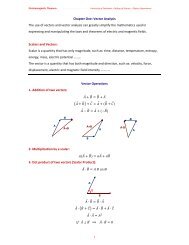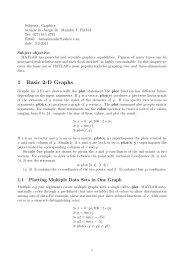An Introduction of Environmental Chemistry
An Introduction of Environmental Chemistry
An Introduction of Environmental Chemistry
You also want an ePaper? Increase the reach of your titles
YUMPU automatically turns print PDFs into web optimized ePapers that Google loves.
<strong>An</strong> <strong>Introduction</strong> <strong>of</strong><br />
<strong>Environmental</strong> <strong>Chemistry</strong><br />
Lecture notes
<strong>Chemistry</strong> has played a major role in the advancement <strong>of</strong> society and in<br />
making our lives longer, healthier, more comfortable, and more enjoyable. The<br />
effects <strong>of</strong> human-made chemicals are ubiquitous and in many instances quite<br />
positive. Without chemistry there would be no pharmaceutical drugs, no<br />
computers, no automobiles, no TVs, no DVDs, no lights, no synthetic fibers.<br />
However, along with all the positive advances that result from chemistry,<br />
copious amounts <strong>of</strong> toxic and corrosive chemicals have also been produced<br />
and dispersed into the environment. Historically, chemists as a group have not<br />
always paid enough attention to the environmental consequences <strong>of</strong> their<br />
activities.
Environment is the sum total <strong>of</strong> all conditions and influences that affect the<br />
development and life <strong>of</strong> all organisms on earth. The living organisms vary<br />
from the lowest micro-organisms such as bacteria, virus, fungus, etc. to the<br />
highest, including man. Each organism has its own environment.<br />
The functions <strong>of</strong> the environment in relation to man have been analyzed:<br />
1. recreation;<br />
2. source <strong>of</strong> natural resources— agricultural, mineral and forestry which man<br />
consumes directly or indirectly;<br />
3. “sink” for receiving wastes produced by man and his activities. The capacity<br />
<strong>of</strong> the environment to carry out these functions is damaged by human<br />
activities which imposes four stresses on the environment: (i) “eutrophic”, i.e.<br />
the task <strong>of</strong> decomposing wastes produced by consumption and production<br />
activities; (ii) “exploitative”, i.e. cropping <strong>of</strong> plants, extraction <strong>of</strong> minerals and<br />
hunting <strong>of</strong> animals; (iii) disruptive— brought about by activities like<br />
deforestation, construction <strong>of</strong> highways and towns; and (iv) “chemical” and<br />
“industrial” stress which results from industrial development.
<strong>Environmental</strong> chemistry<br />
It can be defined as the study <strong>of</strong> the sources, reactions, transport, effects,<br />
and fates <strong>of</strong> chemical species in the air, soil and water environments; and the<br />
effect <strong>of</strong> human activity on these. <strong>Environmental</strong> chemistry is an<br />
interdisciplinary science that includes atmospheric, aquatic and soil<br />
chemistry, as well as heavily relying on analytical chemistry and being<br />
related to environmental and other areas <strong>of</strong> science.<br />
<strong>Environmental</strong> chemistry deals with the reactions, fates, movements, and<br />
sources <strong>of</strong> chemicals in the air, water, and soil In the absence <strong>of</strong> humans, the<br />
discussion would be limited to naturally occurring chemicals. Today, with the<br />
burgeoning population <strong>of</strong> the Earth, coupled with continually advancing<br />
technology, human activities have an ever-increasing influence on the<br />
chemistry <strong>of</strong> the environment. To the earliest humans, and even until less than<br />
a century ago, humans must have thought <strong>of</strong> the Earth as so vast that human<br />
activity could scarcely have any more than local effects on the soil, water, and<br />
air. Today we realize that our activities can have not only local and regional<br />
but also global consequences.
Pollution<br />
is the introduction <strong>of</strong> contaminants into an environment that causes<br />
instability, disorder, harm or discomfort to the ecosystem i.e. physical<br />
systems or living organisms.<br />
Pollution can take the form <strong>of</strong> chemical substances or energy, such as<br />
noise, heat, or light. Pollutants, the elements <strong>of</strong> pollution, can be<br />
foreign substances or energies, or naturally occurring; when naturally<br />
occurring, they are considered contaminants when they exceed natural<br />
levels. Pollution is <strong>of</strong>ten classed as point source or nonpoint source<br />
pollution.
1. Pollutant:<br />
A pollutant may be defined as anything, living or not living, or any physical agent<br />
(e.g. heat, sound) that in it’s excess makes any part <strong>of</strong> the environment<br />
undesirable.<br />
A pollutant has been defined as any solid, liquid or gaseous, substance present in<br />
such concentration as may be or tend to be injurious to environment.<br />
2. Contaminant:<br />
A contaminant may be defined as something which causes deviation from the<br />
normal composition <strong>of</strong> an environment. A contaminant does not occur in nature<br />
but gets introduced by human activity into the environment, affecting its<br />
composition.<br />
3. Source:<br />
It is generally the logic place from which the pollutant originates. The identity <strong>of</strong><br />
source is important to eliminate pollution.<br />
4. Receptor<br />
It is anything which is affected by the pollutant. Man is the receptor <strong>of</strong> photochemical<br />
smog causing irritation <strong>of</strong> the eyes and respiratory tract.<br />
5. Sink:<br />
It is the medium which is able to retain and interact with a long-lived pollutant.<br />
Limestone wall may be the sink for the atmospheric sulfuric acid, through the<br />
reaction:<br />
H 2 SO 4 + CaCO 3 CaSO 4 + H 2 O + CO 2
6. Pathway <strong>of</strong> the pollutant:<br />
It refers to the mechanism by which the pollutant gets distributed from it’s source into<br />
the environmental segments.<br />
Pb (C 2 H 5 ) 4<br />
PbCl 2 + PbBr 2 (released into the air)<br />
To food crops and food chain.<br />
PbCl 2 + PbBr 2<br />
7. Speciation:<br />
The term is used for different chemical forms or species <strong>of</strong> inorganic or organometallic<br />
compounds which are present in the environment. For example , the<br />
species such as (CH 3 Hg) + and (CH 3 ) 2 Hg have been found to be deadly poisonous as<br />
compared to the other species <strong>of</strong> mercury.<br />
8. Threshold Limit Value (TLV):<br />
It refers to the permissible level <strong>of</strong> a toxic pollutant in atmosphere to which a healthy<br />
industrial worker gets exposed during an eight hour day without getting any<br />
adverse effect. TLV values for Be and Zn have been 0.002 and 1.000 mg/m 3<br />
respectively.
9. Synergism and <strong>An</strong>tagonism:<br />
In many cases the combined effects <strong>of</strong> two or more pollutants are more severe or even<br />
qualitatively different from the individual effects <strong>of</strong> separate pollutants- a phenomenon known<br />
as synergism. Some times the combined effects <strong>of</strong> two pollutants are less rather than more<br />
severe, and this situation is referred to as <strong>An</strong>tagonism.<br />
Cyanide in industrial wastes are quite poisonous to aquatic life, and in the presence <strong>of</strong> zinc or<br />
cadmium they are extremely poisonous (synergistic effect), apparently due to the formation <strong>of</strong><br />
complexes; in the presence <strong>of</strong> nickel, however, a nickel-cyanide complex that is not very toxic is<br />
formed.
COMPONENTS OF THE EARTH/ ENVIRONMENTAL SEGMENTS<br />
1. Lithosphere<br />
The earth’s crust, made <strong>of</strong> the mantle <strong>of</strong> rocks, is the lithosphere. It includes the soil<br />
which covers the rock’s crust in many places. Rocks are subjected to continuous<br />
weathering forces—rain, wind, chemical and biological. The resulting primitive soil is<br />
suitable for the growth <strong>of</strong> plants—after death and decay, plant debris returns to soil.<br />
Soil has a loose structure consisting <strong>of</strong> solid mineral and organic matter, air spaces. It<br />
shows broadly three zones as its depth increases. The top layer, up to several inches<br />
thick, is known as the top soil which is an index <strong>of</strong> the soil quality. This is the layer <strong>of</strong><br />
maximum biological productivity and it contains bulk <strong>of</strong> the organic matter. Hence it<br />
is very important for vegetation cover and agricultural crops. Reckless deforestation<br />
causes loss <strong>of</strong> top soil which also means loss <strong>of</strong> agricultural production. The underlying<br />
layer is the sub-soil which receives organic matter, salts and clay particles leached<br />
from the top soil. The third layer (zone) consists <strong>of</strong> weathered parent rocks from<br />
which the soil was formed. Plants draw water and nutrients from soil—they transport<br />
water into the plant body (roots and leaves) and then excess water into the<br />
atmosphere through leaves by the process <strong>of</strong> transpiration. Soils have an important<br />
function, i.e. exchange <strong>of</strong> cations whereby essential trace metals are made available to<br />
plants as nutrients.
2. Hydrosphere<br />
The hydrosphere consists <strong>of</strong> all types <strong>of</strong> water resources— oceans, seas, rivers, lakes,<br />
streams, reservoirs, glaciers, polar ice caps and ground water (i.e. water below the<br />
earth’s surface). Surface water gets polluted by domestic sewage, industrial waste<br />
and agricultural run-<strong>of</strong>f including pesticides and fertilizers. Water-borne diseases<br />
from sewage alone kill millions <strong>of</strong> people in developing countries.
3. Atmosphere<br />
The major components <strong>of</strong> the atmosphere are nitrogen and oxygen while the minor<br />
components are argon, carbon dioxide and some trace gases.<br />
4. Biosphere<br />
The biosphere consists <strong>of</strong> the earth’s crust, hydrosphere, atmosphere and various<br />
The biosphere consists <strong>of</strong> the earth’s crust, hydrosphere, atmosphere and various<br />
living species (microorganisms to man) which exist in the zone 600 meters above<br />
earth’s surface and 10,000 meters below sea level. Both biosphere and environment<br />
have close interactions with each other. Thus oxygen and carbon dioxide levels <strong>of</strong> the<br />
atmosphere depend entirely on the plant world. Green plants alone are responsible<br />
for the accumulations <strong>of</strong> oxygen in the atmosphere through photosynthesis and decay.<br />
In the early stages atmosphere was devoid <strong>of</strong> oxygen and there was no life<br />
form on earth.
Types <strong>of</strong> pollution<br />
1. Air Pollution<br />
Air pollution is the presence <strong>of</strong> materials in air in such concentration which are harmful to<br />
man and his environment. Various causes <strong>of</strong> air pollution are:<br />
Category Examples Important pollutants<br />
1. Chemical plants<br />
Petroleum refineries, fertilizers,<br />
cements, papermills, ceramic clay<br />
products, glass manufacture<br />
2. Crop spraying Pesticides and weedicides<br />
3. Fuel burning<br />
4. Metallurgy plants<br />
Domestic burning, thermal power<br />
plants<br />
Aluminium refineries and steel<br />
plant<br />
5. Nuclear device testing Bomb explosions<br />
6. Ore preparations Crushing, grinding and screening<br />
7. Spray painting, ink, solvent<br />
cleansing<br />
8. Transportation<br />
Printing and chemical<br />
separations, furniture, dyeing<br />
Cars, trucks, aeroplanes and<br />
railways<br />
H 2 S, sulphur oxide, fluorides,<br />
organic vapours and dust<br />
Organophosphates, chlorinated<br />
hydrocarbons, lead, arsenic<br />
Sulphur and nitrogen oxides<br />
Metal flumes (Pb and Zn)<br />
fluorides and particulates<br />
Radioactive fall out, Sr-90, Cs-137,<br />
C-14 etc.<br />
Uranium and beryllium dust,<br />
other particulates<br />
Hydrocarbons and other organic<br />
vapours<br />
CO, NO, NO2, Pb, smoke, soot,<br />
smoke organic vapours etc.

















